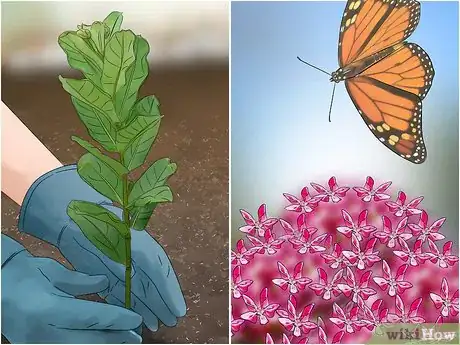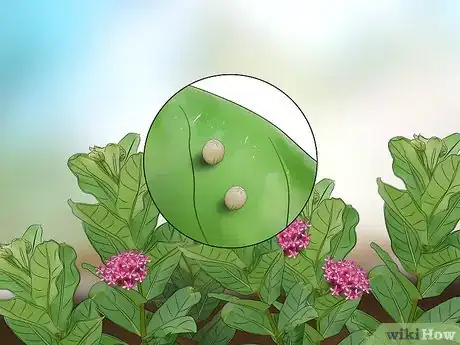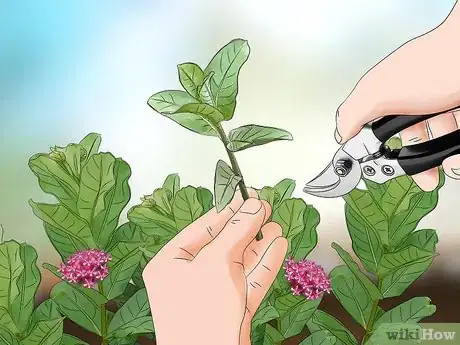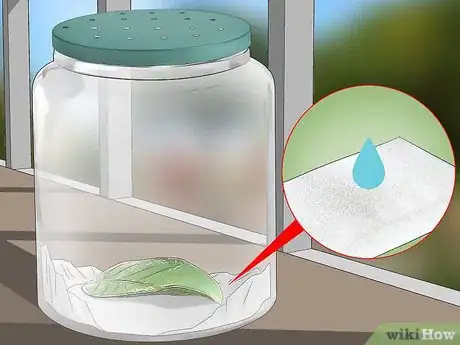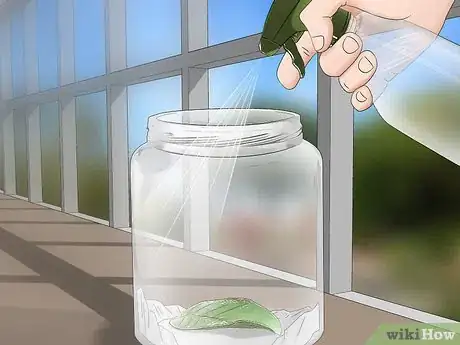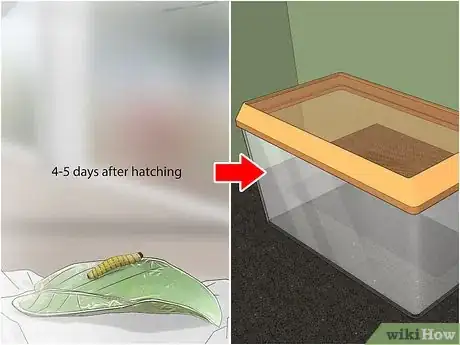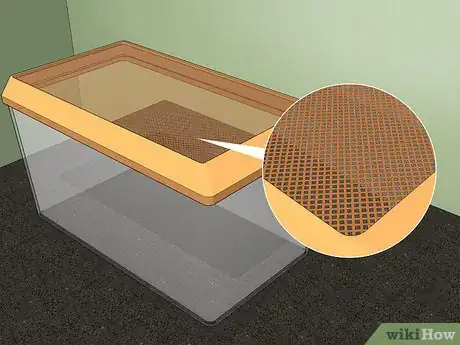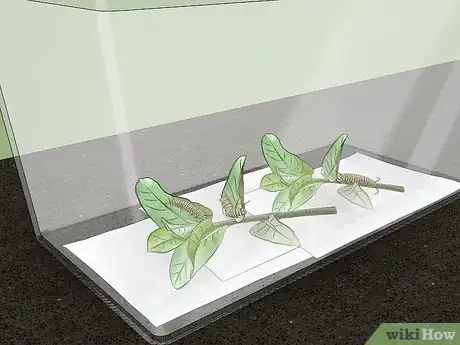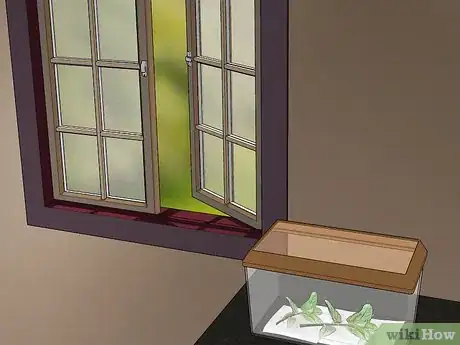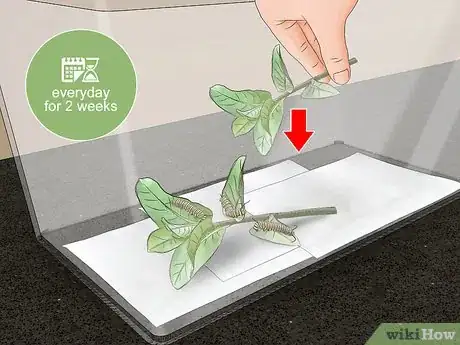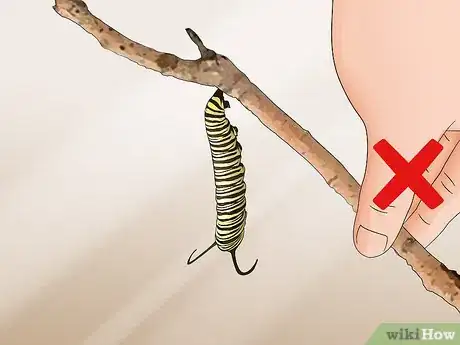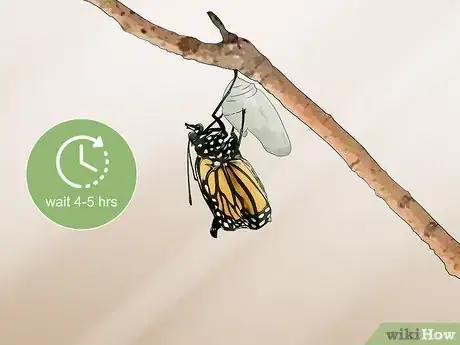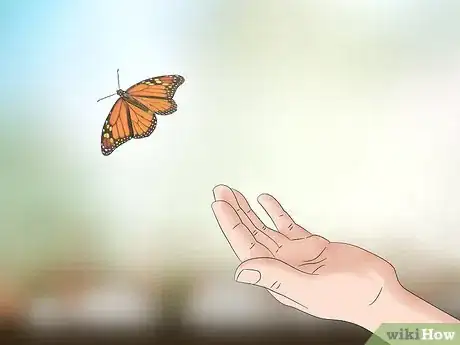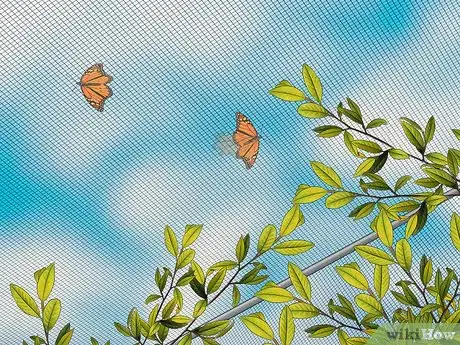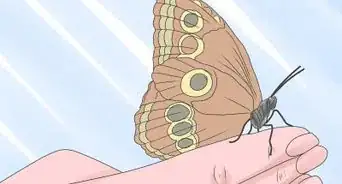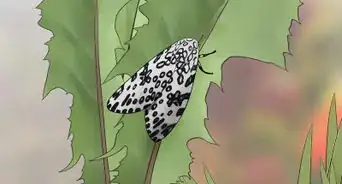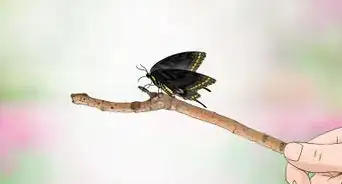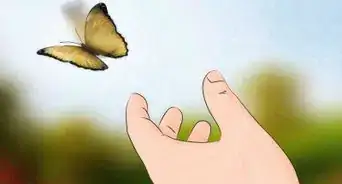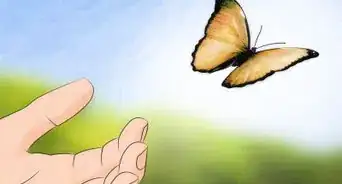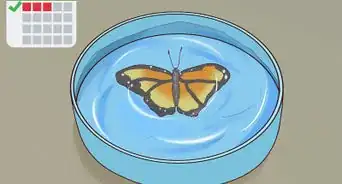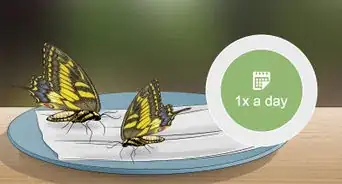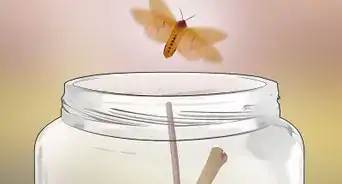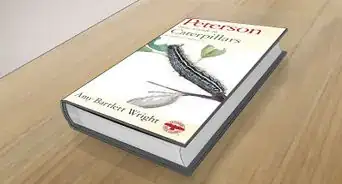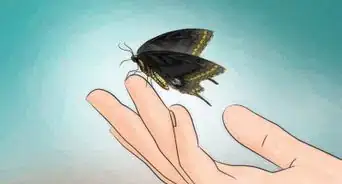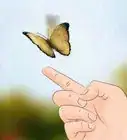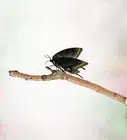This article was co-authored by Shweta Sharma and by wikiHow staff writer, Amy Bobinger. Shweta Sharma is a Biologist with the U.S. Environmental Protection Agency (EPA). With nearly ten years of experience, she specializes in insect management, integrated pest management, insect behavior, resistance management, ecology, and biological control. She earned her PhD in Urban Entomology and her MS in Environmental Horticulture from the University of Florida. She also holds a BS in Agriculture from the Institute of Agriculture and Animal Sciences, Nepal.
wikiHow marks an article as reader-approved once it receives enough positive feedback. This article has 17 testimonials from our readers, earning it our reader-approved status.
This article has been viewed 175,039 times.
Monarch butterflies are known for their distinctive orange and black pattern, but the caterpillars also have their own unique look, featuring unique black, yellow, and white stripes. Raising Monarch caterpillars into butterflies is a fun way to experience one of nature’s most dramatic transformations. Even better, raising these caterpillars can actually help with efforts to conserve this beautiful species!
Steps
Gathering the Eggs or Caterpillars
-
1Find or plant milkweed somewhere near you. Monarch caterpillars feed exclusively on milkweed plants, and female butterflies lay their eggs on the plants so their larvae will have plenty of food. If you want to find Monarch caterpillars, either plant milkweed in your yard, or explore overgrown land in your area to find plants that are already growing.
- The exact appearance of milkweed will vary depending on the variety, but they typically feature a stalk with broad leaves. It’s very easy to identify milkweed if it’s flowering, since the flowers have a distinctive star shape. Also, if the stalk or leaves are damaged, the plant will secrete a milky fluid, which is where it gets the name “milkweed.”[1]
- Milkweed grows in areas where the ground has been disturbed. For example, you might find it growing along a roadside, bike path, or railroad tracks, or you could spot some in a pasture, park, or overgrown garden.
- Before you head out to look for milkweed plants, do an online search for pictures of the plant, or check a plant identification guide.
-
2Check the milkweed every day during the spring and summer for eggs. Once you’ve located a milkweed plant, check it every day starting in the spring. Monarch eggs are yellow, and round, are about the size of a pencil tip, and are usually found on the underside of the leaf. There is typically only 1 egg on a leaf, and often a female monarch will only lay 1 egg on each milkweed plant.[2]
- Monarch eggs hatch within 4 or 5 days, so it helps to spot the eggs as early as possible.
- If you haven’t checked the plant for a few days, you may spot Monarch caterpillars instead of their eggs. Newly-hatched caterpillars will be about the size of a grain of rice, with smooth bodies and faint black, yellow, and white stripes. Older caterpillars will have the same distinct stripes but will be larger, growing up to 1–1 1⁄2 in (2.5–3.8 cm) before they transform into a butterfly.[3]
Advertisement -
3Cut down the entire stalk when you see eggs or larvae. To protect the fragile Monarch eggs or newly-hatched larvae, it’s best to leave them on the leaf. Either snap the milkweed stalk with your hands or gently pluck off the leaf containing the egg, then carry it back to your home.[4]
- Taking the whole stalk will provide you with plenty of food for your hungry caterpillar, but if you like, you can just gather a few leaves.
- Remember to check the whole plant to make sure it’s not hiding any other insects or their eggs. If you see anything that's not a monarch caterpillar or egg, either brush away the insect or remove the leaf that contains the egg.
- To keep the milkweed stalk fresh, wrap the end in wet paper towels, then in aluminum foil. You could also use foam floral tubes if you have access to florist supplies.
Tip: Wash your hands with soap and water after you handle milkweed, as the sap can be irritating to your skin and eyes.
-
4Keep the eggs in a small container lined with a moist paper towel. Once you get the milkweed inside, sprinkle a few drops of water onto a paper towel, then place it in the bottom of a small container, like a glass jar or a food storage container. If you brought the entire stalk of milkweed, carefully snip off the leaf with the egg, then place the leaf egg-side-up into the container.
- Cover the container with a lid made of mesh or one that has holes to allow air to circulate.
- The water on the paper towel will keep the milkweed leaf from drying out.
- If you found caterpillars that were already hatched, you can move them directly to their permanent enclosure, instead.
-
5Sprinkle a few more drops of water on the paper towel each day. When the larvae emerge from their eggs, they'll get their food and their water intake by eating the milkweed leaves they were attached to. Adding a few drops of water each day will keep the milkweed from drying out while you wait for the eggs to hatch.
- Keep doing this until the eggs hatch, which typically takes about 4 days.
-
6Move the larvae to their enclosure within 4-5 days of hatching. You can safely wait to move the larvae until they’re about 4 or 5 days old, since they won’t crawl until then. Once they’re 4 or 5 days old, they should be about 1 in (2.5 cm) long, and they’ll be ready to go to their main enclosure. If a caterpillar is crawling on a leaf, you can pick up the whole leaf and move it to a new enclosure. If it's on the bottom or side of the container, gently pick it up with your fingers to move it.[5]
- By hatching the eggs in a small container, you’ll be able to keep a close eye on their progress. Also, if you’re raising multiple generations of caterpillars, having a separate container for hatching the eggs will help prevent the spread of illness, since you’ll only be moving healthy caterpillars to the larger enclosure.[6]
- If you're worried about damaging the larvae when you move them, lightly moisten the bristles of an artist's paintbrush, then slide each caterpillar onto the brush to transfer it.
Setting up the Caterpillar Enclosure
-
1Choose a medium-sized container with a tight-fitting mesh top. Your imagination is the limit when it comes to creating your caterpillar enclosure! If you’re only raising 1 or 2 Monarch caterpillars, you could use a shoebox or a clean food container, or you could use an aquarium if you'll be raising more caterpillars and you want to give them a larger enclosure. Just make sure whatever container you choose is at least 4 in (10 cm) deep, so your adult butterfly will have room to spread its wings.
- Once your caterpillars start crawling, they’ll be able to escape from your container if it’s not fitted with a secure lid. However, make sure the lid is easy to open, since you’ll need to clean the enclosure every day.
- Also, they’ll need plenty of ventilation, so opt for a lid made of mesh, screen, or netting.
- A container with clear sides will allow you to see the caterpillars as they develop, but it’s not necessary.
Tip: If you don’t have any mesh, try stretching pantyhose across the top of a container. Secure them in place with a rubber band.
-
2Line the container with damp paper towels and fresh milkweed leaves. Just like in your egg enclosure, a little water on a paper towel will help keep your milkweed leaves from drying out. Your caterpillars will be very hungry as they grow, so make sure you have several fresh milkweed leaves for each larva. You can even put whole stalks of milkweed in the enclosure if the container you chose is large enough.
- To avoid introducing any unwanted insects or bacteria into your enclosure, rinse off the milkweed leaves under cool running water before you place them in the container.
- If you’re putting individual leaves in the container, you’ll need to add fresh leaves to the container each day. You’ll also need to replace whole stalks when the leaves start to curl, turn brown, or look dry.
- You can add sticks to the enclosure to prop up the milkweed stalks if you like.
-
3Keep your container in a window that doesn't get direct sunlight. Your Monarch caterpillars will love indirect natural light, so place the container near a window. However, if they get too hot, they could die, so make sure it’s not a window where the sun will be shining directly onto the caterpillars.[7]
- Also, make sure your container is out of the path of any air conditioner vents. The strong air and fluctuating temperatures can be dangerous for your small caterpillars.
Raising and Releasing Your Caterpillars
-
1Clean the container once a day. To keep your caterpillars healthy and happy, it’s important to keep their enclosure clean. Carefully remove any leaves and set them aside. If there are caterpillars on the leaves, it’s still fine to move them. Just keep an eye on them so they don’t crawl away. Replace the paper towels in the bottom of the enclosure, and wipe down the sides of the container with a damp cloth.[8]
- When you’re finished, add fresh milkweed and return any old leaves that had caterpillars on them.
- Caterpillars produce a lot of droppings, which are called frass. You'll be able to see these small black or brown specks on the bottom of the container. Leaving the frass in the enclosure can cause your Monarch caterpillars to get very sick.
-
2Provide your caterpillar with fresh milkweed every day for 2 weeks. Each caterpillar should get about 2-3 fresh leaves a day, even though they won’t eat all of it. This will help them feel comfortable as they gather energy for their eventual transformation. During these 2 weeks, you’ll see your caterpillars growing dramatically.[9]
- Your caterpillars will molt about 5 times during this period. They’ll often get very still on the side or the top of the container, and you may even see their black head capsule come off. This is perfectly natural, but do not touch your caterpillars during this time, and try to avoid moving the container. If they're attached to the lid, lift it away carefully when you're cleaning.[10]
- Each time the larvae molt, they enter a new stage, or instar, for a total of 5 instars. These are primarily distinguished by the caterpillar's size, the length of the front and back tentacles, and the development of its stripes, which start to appear near the end of the first instar.
- Unfortunately, it’s normal for some of your caterpillars to die during this 2-week period. As long as you’re keeping their cage clean and giving them fresh leaves, the healthy caterpillars should survive. Be sure to remove any dead larvae as soon as you see them, though. You'll typically see dead caterpillars lying on the floor of the enclosure.
-
3Do not disturb the larvae when they attach to a leaf or the container. After about 2 weeks, your caterpillars will be ready to start their transformation into butterflies. When a larva is ready to pupate, it will attach itself to the top or side of the enclosure, or to the bottom of a leaf, with a strand of silk. It will take about 24-36 hours to form a chrysalis, and it’s important not to try to move the larva during this time. If it's attached to the lid, move it carefully when you need to clean the tank.[11]
- If all of your caterpillars have started their transformation, you won't need to clean the cage again until after you release the butterflies.
- Before a caterpillar starts to change, you may notice that its front tentacles start to droop, and it may be less active than normal.
- The chrysalis will be light green, although it may darken toward the end of the process.
-
4Watch for your butterfly to emerge after about 10-15 days. Once the caterpillar forms its chrysalis, the only thing left to do is to wait. While it might not look like much is going on, your caterpillar is undergoing an amazing, dramatic transformation. Monarchs typically emerge in the middle of the morning after about 10-15 days.[12]
- If you have other caterpillars that haven’t started to pupate yet, continue to provide them with fresh milkweed. Of course, be very careful lifting the lid of the container if there’s a chrysalis attached.
-
5Do not touch the butterfly for 4-5 hours after it hatches. A newly-hatched butterfly will have folded, wet wings, and it’s very important to give it time to dry on its own. If you touch it during the first 4 or 5 hours after it hatches, you could damage its fragile wings.[13]
- After just a few hours, your butterfly will be ready to fly!
-
6Release your butterfly the same day it hatches whenever possible. In order to give your Monarch butterfly the best chance at laying its own eggs, you should release it as soon as you can. Carefully scoop your hands around the butterfly, holding it so that all 4 of its wings are closed vertically. Then, take the butterfly outside and open your hands. It should just fly away!
- It’s best to release your butterfly on a warm, sunny day. If you need to, you can keep the hatched butterfly in the caterpillar enclosure for up to a day while you wait for the right weather conditions.[14]
-
7Move the butterfly to a bigger cage if you're keeping it. While it’s best to release your Monarch butterfly into the wild right away, if you want or need to keep it inside, you should move it to a larger enclosure. You can use a mesh tent, a butterfly cage, or another similar container, but don’t keep it with the caterpillars for longer than a day.[15]
- Put a small dish with a little sugar water and a cotton ball in the butterfly cage for your butterfly to drink. Change the water daily.[16]
- Clean out the bottom of the cage each day when you're changing the water. Wipe it down with a damp cloth to remove any frass.
- Keeping adult butterflies in an enclosure with caterpillars could lead to the spread of the OE parasite, which causes dark gray marks to form on the pupae, and your butterflies may not hatch successfully.
Community Q&A
-
QuestionI have monarch caterpillars now on my parsley; it's October in New Jersey. Will they live? What should I do?
 Karen EveCommunity AnswerIf they are on parsley, they are not monarchs. Parsley is a host plant for Eastern black swallowtail. If you have enough parsley and it becomes a chrysalis, butterflies usually won’t fly when temperatures are less than 55 or 60 degrees so many people "overwinter" the chrysalis.
Karen EveCommunity AnswerIf they are on parsley, they are not monarchs. Parsley is a host plant for Eastern black swallowtail. If you have enough parsley and it becomes a chrysalis, butterflies usually won’t fly when temperatures are less than 55 or 60 degrees so many people "overwinter" the chrysalis. -
QuestionHow do you find the Monarch?
 Karen EveCommunity AnswerJust put lots of milkweed in your yard and they will come. You can just leave the caterpillars alone if you want, most should do fine outside. You can buy seeds or plants but be careful there aren't pesticides on the plants.
Karen EveCommunity AnswerJust put lots of milkweed in your yard and they will come. You can just leave the caterpillars alone if you want, most should do fine outside. You can buy seeds or plants but be careful there aren't pesticides on the plants. -
QuestionI have several caterpillars that are going into their crysalis stage. Two have died from where they attached themselves to the edge of the pot. Why did this happen?
 Community AnswerThey may not be dead. Leave them be unless you are sure they are dead (liquid or black spots).
Community AnswerThey may not be dead. Leave them be unless you are sure they are dead (liquid or black spots).
Warnings
- Milkweed is often toxic to other animals, so make sure to keep any extra stalks away from other pets.⧼thumbs_response⧽
Things You'll Need
Gathering the Eggs
- Milkweed plants
- Small container
- Paper towels
- Water
- Artist's paintbrush (optional)
Setting up the Caterpillar Enclosure
- Container - at least 4 in (10 cm) deep with mesh or screen lid
- Paper towels
- Water
- Milkweed leaves or stalks
- Sticks (optional)
Raising and Releasing Your Caterpillars
- Damp cloth for cleaning
- Fresh milkweed leaves
- Butterfly cage (optional)
- Sugar water (optional)
- Tray (optional)
- Cotton ball (optional)
Expert Interview

Thanks for reading our article! If you'd like to learn more about butterflies, check out our in-depth interview with Shweta Sharma.
References
- ↑ https://www.saveourmonarchs.org/som-blog/how-to-identify-milkweed-plants-quickly-and-confidently
- ↑ https://monarchwatch.org/rear/
- ↑ https://www.goodhousekeeping.com/home/gardening/a20707496/raise-monarch-butterflies/
- ↑ https://monarchwatch.org/rear/
- ↑ https://www.saveourmonarchs.org/how-to-raise-monarch-butterflies-at-home.html
- ↑ https://monarchwatch.org/rear/
- ↑ https://www.goodhousekeeping.com/home/gardening/a20707496/raise-monarch-butterflies/
- ↑ https://www.saveourmonarchs.org/how-to-raise-monarch-butterflies-at-home.html
- ↑ https://www.goodhousekeeping.com/home/gardening/a20707496/raise-monarch-butterflies/
- ↑ https://monarchwatch.org/rear/
- ↑ https://www.goodhousekeeping.com/home/gardening/a20707496/raise-monarch-butterflies/
- ↑ https://www.saveourmonarchs.org/how-to-raise-monarch-butterflies-at-home.html
- ↑ https://www.goodhousekeeping.com/home/gardening/a20707496/raise-monarch-butterflies/
- ↑ https://monarchwatch.org/rear/
- ↑ https://www.saveourmonarchs.org/how-to-raise-monarch-butterflies-at-home.html
- ↑ https://www.goodhousekeeping.com/home/gardening/a20707496/raise-monarch-butterflies/
- ↑ https://monarchwatch.org/rear/
About This Article
If you want to catch and raise monarch caterpillars, the easiest way is to gather caterpillars or eggs from milkweed plants. If you find an egg, pull the leaf off of the plant and place it in a small container lined with a moist paper towel. Each day, sprinkle a few drops of water onto the paper towel. If you find caterpillars, or once the eggs hatch and the larvae are 4-5 days old, move them to a larger enclosure fitted with a mesh top lined with paper towels. Each day, replace the paper towels, wipe down the container, and give the caterpillar fresh milkweed. Once the adult butterflies emerge, wait for the wings to dry out, then release them into the wild. For tips on how to identify monarch eggs and caterpillars, read on!
